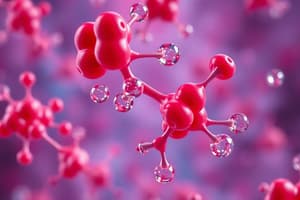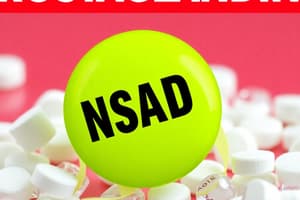Podcast
Questions and Answers
Which class of eicosanoids is primarily responsible for inducing inflammation?
Which class of eicosanoids is primarily responsible for inducing inflammation?
- Prostacyclins
- Prostaglandins (correct)
- Thromboxanes
- Leukotrienes
What symptom is NOT typically associated with the effects of eicosanoids?
What symptom is NOT typically associated with the effects of eicosanoids?
- Weight loss (correct)
- Fever induction
- Pain signals
- Smooth muscle contraction
In the provided patient profile, what elevated plasma levels are significant indicators of inflammation?
In the provided patient profile, what elevated plasma levels are significant indicators of inflammation?
- Prostaglandin E2 and leukotriene B4 (correct)
- C-reactive protein and erythrocyte sedimentation rate
- Leukotriene A4 and prostacyclin I2
- Prostaglandin E1 and thromboxane A2
Which treatment for inflammatory arthritis primarily targets eicosanoid pathways?
Which treatment for inflammatory arthritis primarily targets eicosanoid pathways?
Which eicosanoid is most likely to facilitate smooth muscle relaxation?
Which eicosanoid is most likely to facilitate smooth muscle relaxation?
What lifestyle modification could help modulate inflammation according to the treatment considerations?
What lifestyle modification could help modulate inflammation according to the treatment considerations?
Which class of eicosanoids is primarily produced during the platelet aggregation process?
Which class of eicosanoids is primarily produced during the platelet aggregation process?
What is the primary reason that only free hormones are biologically active?
What is the primary reason that only free hormones are biologically active?
Which type of binding proteins has high affinity but low capacity?
Which type of binding proteins has high affinity but low capacity?
What percentage of steroid hormones is typically free in circulation?
What percentage of steroid hormones is typically free in circulation?
How do binding proteins affect hormone levels in the bloodstream?
How do binding proteins affect hormone levels in the bloodstream?
Why are steroid hormones transported primarily bound to proteins?
Why are steroid hormones transported primarily bound to proteins?
What role does equilibrium between free and bound hormones play in the body?
What role does equilibrium between free and bound hormones play in the body?
What is the consequence of a higher concentration of bound hormones?
What is the consequence of a higher concentration of bound hormones?
Which of the following best describes non-specialized binding proteins?
Which of the following best describes non-specialized binding proteins?
What is the concentration of cortisol typically found in the blood?
What is the concentration of cortisol typically found in the blood?
What characterizes chronic hormone secretion?
What characterizes chronic hormone secretion?
What happens during down-regulation of hormone receptors?
What happens during down-regulation of hormone receptors?
What effect does up-regulation have on hormone sensitivity?
What effect does up-regulation have on hormone sensitivity?
Which of the following statements is true regarding protein/peptide hormones?
Which of the following statements is true regarding protein/peptide hormones?
In relation to receptor location, what is the role of the ligand-binding domain?
In relation to receptor location, what is the role of the ligand-binding domain?
What is the primary reason for the desensitization of some drugs?
What is the primary reason for the desensitization of some drugs?
Which domain of a membrane receptor interacts with other intracellular molecules?
Which domain of a membrane receptor interacts with other intracellular molecules?
When the synthesis of receptors increases upon hormone stimulation, this phenomenon is known as:
When the synthesis of receptors increases upon hormone stimulation, this phenomenon is known as:
Chronic hormone secretion is best characterized by which of the following?
Chronic hormone secretion is best characterized by which of the following?
Flashcards
What are eicosanoids?
What are eicosanoids?
Eicosanoids are lipid-derived signaling molecules involved in a wide range of physiological processes, including inflammation, pain, and blood clotting.
What are prostaglandins?
What are prostaglandins?
Prostaglandins are a type of eicosanoid that regulate various processes like inflammation, pain, and blood clotting.
What are thromboxanes?
What are thromboxanes?
Thromboxanes are eicosanoids produced by platelets that promote blood clotting.
What are prostacyclins?
What are prostacyclins?
Signup and view all the flashcards
What are leukotrienes?
What are leukotrienes?
Signup and view all the flashcards
What are HETEs?
What are HETEs?
Signup and view all the flashcards
What are some clinical effects of eicosanoids?
What are some clinical effects of eicosanoids?
Signup and view all the flashcards
How are peptide or protein hormones transported?
How are peptide or protein hormones transported?
Signup and view all the flashcards
How are steroid or amine hormones transported?
How are steroid or amine hormones transported?
Signup and view all the flashcards
What is the significance of free hormone?
What is the significance of free hormone?
Signup and view all the flashcards
What are specialized binding proteins?
What are specialized binding proteins?
Signup and view all the flashcards
What are non-specialized binding proteins?
What are non-specialized binding proteins?
Signup and view all the flashcards
What are the consequences of hormone binding to proteins?
What are the consequences of hormone binding to proteins?
Signup and view all the flashcards
How do hormone levels differ between peptides and steroids?
How do hormone levels differ between peptides and steroids?
Signup and view all the flashcards
What is the typical range of hormone concentrations in blood?
What is the typical range of hormone concentrations in blood?
Signup and view all the flashcards
Is there a standard hormone level for all hormones?
Is there a standard hormone level for all hormones?
Signup and view all the flashcards
Chronic Hormone Secretion
Chronic Hormone Secretion
Signup and view all the flashcards
Acute Hormone Secretion
Acute Hormone Secretion
Signup and view all the flashcards
Episodic (Cyclic) Hormone Secretion
Episodic (Cyclic) Hormone Secretion
Signup and view all the flashcards
Hormone Specificity
Hormone Specificity
Signup and view all the flashcards
Down-Regulation
Down-Regulation
Signup and view all the flashcards
Up-Regulation
Up-Regulation
Signup and view all the flashcards
Receptor Location (Protein/Peptide Hormones)
Receptor Location (Protein/Peptide Hormones)
Signup and view all the flashcards
Extracellular Domain
Extracellular Domain
Signup and view all the flashcards
Cytoplasmic/Intracellular Domain
Cytoplasmic/Intracellular Domain
Signup and view all the flashcards
Study Notes
Major Classes of Eicosanoids
- Prostaglandins
- Thromboxanes
- Prostacyclins
- Leukotrienes
- HETEs
Synthesis of Eicosanoids
- Diacylglycerol or phospholipid are precursors for arachidonic acid
- Arachidonic acid is released from phospholipids by phospholipases
- Arachidonic acid is then converted to prostaglandins, thromboxanes, prostacyclins, and leukotrienes through different enzymes
- COX (Cyclooxygenase) enzymes, Lipoxygenases, Glutathione-S-transferase are involved in the pathway.
- Different enzymes are responsible for the formation of each eicosanoid.
Effects of Eicosanoids
- Induce inflammation
- Mediate pain signals
- Induce fever
- Cause smooth muscle contraction (including the uterus)
- Cause smooth muscle relaxation
- Protect the stomach lining
- Stimulate platelet aggregation
- Inhibit platelet aggregation
- Cause sodium and water retention
Clinical Relevance
- Elevated eicosanoids contribute to inflammation and pain.
- NSAIDs, corticosteroids, disease-modifying antirheumatic drugs (DMARDs) and lifestyle modifications can help modulate the eicosanoid pathway.
Synthesis of Hormone Derivatives of Tryptophan
- L-Tryptophan is converted to 5-hydroxytryptophan
- 5-hydroxytryptophan is converted to serotonin and then
- Serotonin is converted to N-acetylserotonin which further is converted
- N-acetylserotonin is converted to melatonin
Synthesis of Hormone Derivatives of Tyrosine
- Tyrosine is converted to DOPA
- DOPA is converted to Dopamine
- Dopamine is converted to Noradrenaline
- Noradrenaline is converted to Adrenaline
Synthesis of Hormone Derivatives of Tyrosine
- Tyrosine can be iodinated to form thyroxine (T4) and triiodothyronine (T3).
Transport of Hormones
- Peptide/protein hormones: dissolve easily in plasma, but still bound to carrier proteins.
- Steroid/amine hormones: mostly bound to proteins in plasma, resulting in a relatively low concentration of free hormones.
- Free (unbound) hormones are biologically active.
Binding Hormones
- Specialized binding proteins: High affinity, low capacity, present in small amounts (e.g. CBG, TBG).
- Non-specialized binding proteins: Low affinity, high capacity, binds steroids and thyroid hormones (e.g. plasma albumins).
Consequences of Binding
- Prevents overaction of hormone
- Prolongs hormone effect
- Prevents large fluctuations in active hormone levels
- Increases total hormone-carrying capacity of blood
Hormone Concentration in Blood
- Peptide hormones have low levels (e.g., 10⁻¹² to 10⁻⁹ M)
- Steroid hormones have much higher levels (e.g., 10⁻⁷ to 10⁻¹⁰ M)
- Aldosterone is an exception, very low level
Patterns of Hormone Secretion
- Chronic: relatively constant concentration over time
- Acute: in response to a stimulus
- Episodic/Cyclic: fluctuating concentration over time
Hormone Specificity
- Hormones affect only target tissues with specific receptors.
- Receptor numbers are not constant; they are regularly degraded and replaced.
- Downregulation: decrease in synthesis of receptors after prolonged exposure, making targets less sensitive to the hormone.
- Upregulation: increase in synthesis of receptors after prolonged low exposure, making targets more sensitive to the hormone.
Receptor Location – Protein/Peptide Hormones
- Receptors are located on the plasma membrane
- Extracellular domains: exposed to the exterior, bind the hormone (ligand).
- Transmembrane domains: span the membrane, providing structural support.
- Cytoplasmic or intracellular domain interacts with intracellular molecules generating signals and triggering responses
- Ligand-Binding domain, Transmembrane domains, Extracellular domain
cAMP Second Messenger System
- Hormones bind to receptors activating G protein.
- G protein activates adenylate cyclase.
- Adenylate cyclase converts ATP to cyclic AMP (cAMP).
- cAMP activates protein kinase.
- Protein kinase initiates various cellular responses.
Turning off the signal:
- Gα hydrolyzes GTP to GDP+Pi, thus inactivating G protein, thereby stopping the cycle.
- Phosphodiesterases catalyze the hydrolysis of cAMP to AMP terminating the second messenger signal.
Various Cellular Responses from cAMP
- Cellular responses include: enzyme secretion, lipid breakdown, glycogen synthesis, glycogen breakdown.
other protein hormone receptors
- Trans-membrane receptor tyrosine kinases such as insulin and growth factors.
- Activation of intracellular signal pathways.
- Dimerization and autophosphorylation (in many cases).
Steroid Hormone Action
- Steroid hormones diffuse across the plasma membrane due to their lipid solubility.
- Steroid hormones bind to intracellular receptors.
- Hormone-receptor complex binds to DNA.
- Changes gene expression.
- New proteins are synthesized resulting in a particular cellular response.
Thyroid Hormone Nuclear Receptor
- Thyroid hormone (T3 and T4) bind to intracellular receptors.
- Hormone-receptor complex binds to DNA, triggering changes in gene expression.
- Synthesis of new proteins leading thyroid response.
Hormones to Act Via cAMP
- Adrenocorticotropic hormone (ACTH), Follicle stimulating hormone (FSH), Luteinizing hormone (LH), Thyroid stimulating hormone (TSH), Chorionic Gonadotropins (hCG), ß endorphins and enkephalins, Antidiuretic hormone (ADH), Glucagon, parathyroid hormone (PTH), Calcitonin, Epinephrine, Norepinephrine also act through cAMP second messenger system
Hormones to Act Via cGMP
- Atrial Natriuretic Factor (ANF), Nitric Oxide (NO)
ACT Via Phosphotydyl Inositol/Calcium
- Thyrotropin releasing hormone (TRH), Gonadotropin-releasing hormone (GnRH), Gastrin, Cholecystokinin (CCK).
Known to Act Via Tyrosine Kinase/Phosphatase Cascade
- Insulin, Growth hormone (GH), Prolactin (PRL), Oxytocin, insulin-like growth factors (IGF-1, IGF-II)
Studying That Suits You
Use AI to generate personalized quizzes and flashcards to suit your learning preferences.





